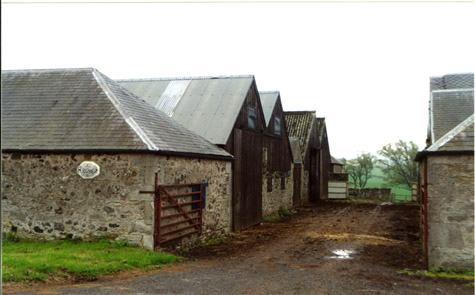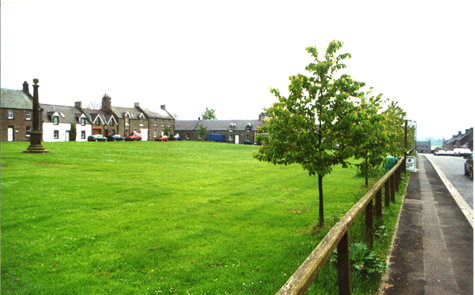

Elliott, Bruce, 2004-2005: Emigrant Recruitment by the New Brunswick Land
Company: The Pioneer Settlers of Stanley and Harvey.********************************************************************************
Medium sized pop up image
700 X 435, 72 dpi, 104 kFull sized pop up image
2407 X 1495, 400 dpi, 1625 kOutbuildings at the substantial farm called Trows near Roxburgh. Stanley settlers Thomas Jaffrey and Susanna (Gray) worked at Trows from 1797 to 1810. In 1816 Thyomas was a hind in Scraesburgh, Jedburgh parish, and later still they resided at Yetholm. There they left several grown children when they sailed fro New Brunswick in 1836. As hinds were hired annually, such changes of residentce were frequent. Source: Bruce S. Elliott, 2002.
Though the Colonist termed the Berwick party "regular practical farmers" and "virtuous yeomanry", a new arrival of 1841 observed that "almost all the first settlers (who came out in 1836) were agricultural labourers, without any capital", (45) and the English press reports confirm this assessment of their status. All were literate, for we have their well-formed signatures on a later document. (46) Their literacy was a testimony to the comparatively secure lives of labourers in the Borders a generation earlier, as it was also to the Presbyterianism of the majority. Presbyterians emphasized the importance of being able to read the Bible for oneself. As most of the men were married, they were likely from the class of agricultural worker known as hinds, and we know this of a certainty for families whose occupations are given in some of the Presbyterian baptismal registers in the homeland.
Medium sized pop up image
700 X 435, 72 dpi, 117 kFull sized pop up image
2407 X 1495, 400 dpi, 1889 kVillage square in Swinton, Berwickshire, identifies the village as an Anglian foundation. Swinton was the ancestral home of Stanley's Kerr familiy. John Kerr met and married his wife while both were servants to a Capt. Hall at Annsfield in Coldingham, but returned as labourers to Swinton to have their younger children. Thomas's father was a shoemaker here. Source: Bruce S. Elliott, 2002.
Most farms in the Borders were large, comprising hundreds of acres of productive land, and each farm typically had a row of stone cottages occupied by the hinds, or married farm workers. A description of farmsteads on the Scottish side of the border applies equally to those in northern Northumberland:
Improved farmhouses, increasingly set aside from the steading, were based on 18th-century manses or minor lairds' houses, symmetrical to a plain, four-square, two-storey block with central staircase. Farm cottages too, estate- or farm-built, tended to be symmetrical, neat and functional in pairs or terraces. A row of such tied cottages, flower garden in front, vegetable garden behind, is still a distinctive landscape feature particularly in East and Midlothian and Berwickshire which, with 6-8 farm servants to a farm, had the largest labour teams in Scotland. The adjacent districts generally had 4-5. The cottages were occupied by married farmworkers, descendants in many areas of the previously dispossessed joint-tenant farmers; unmarried males were generally housed collectively in single-room bothies built into the steading. (47)
_________________________________________________________________________
(45) Letter of James Neales, Stanley, 9 November 1841, reprinted by the Company in Practical Information Respecting New Brunswick (London, 1843), 35 from the Doncaster Gazette of 21 January 1842. CIHM N.21901.
(46) C.O. 188/61, ff. 388-9, NA reel B-15.
(47) John Baldwin, Exploring Scotland's Heritage: Edinburgh, Lothians and Borders (Edinburgh: The Stationery Office,1997), 77.

